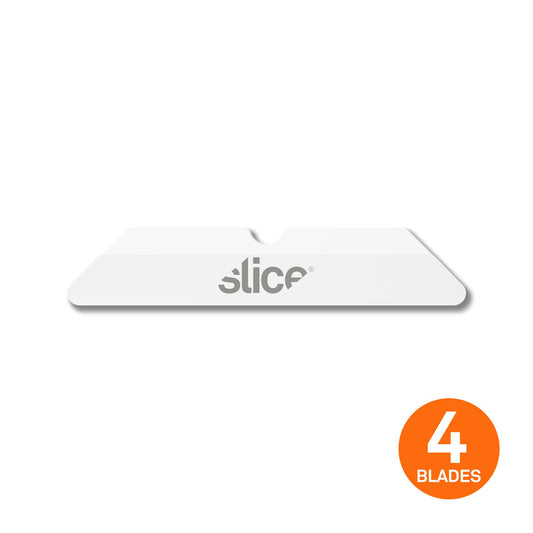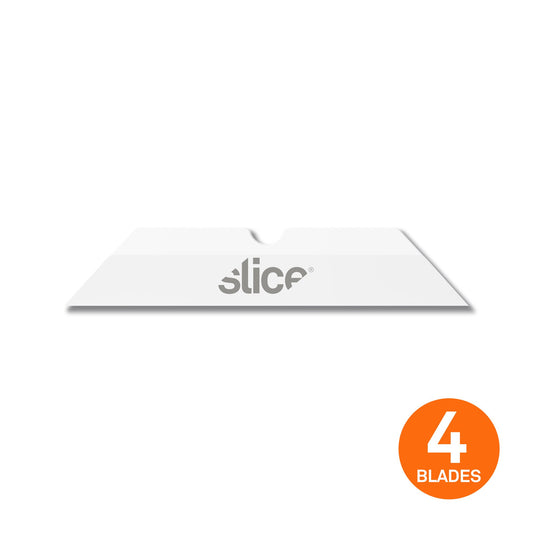Translation missing: ja.accessibility.faq_content_title
The Sharpest Box Cutter Blade Is the Safest, Right?
Once you’ve made the decision to purchase a box cutter for your workplace, it’s time to consider the blade. Slice® blades keep safety top of mind. Dull box cutter blades are notoriously unsafe because they require more pressure to move through material, which means an accidental slip will have more force behind it—and that force is typically headed straight toward the user. Because of this, people assume that the sharper a box cutter blade is, the safer it will be. Well, this isn’t true either. A blade really only needs a certain amount of sharpness to effectively cut material. Anything sharper cuts skin too easily.
So why would anyone make a blade that’s dangerously sharp? Traditional blades are made of metal, which dulls very quickly. If manufacturers sharpened metal blades only enough to cut effectively, they would dull so quickly that they’d be virtually useless. That’s why metal blades start off overly sharp. This method prioritizes product lifespan over user safety.
Traditional ceramic blade manufacturers simply copy metal blade designs, sharpening their blades to dangerous levels, too. Slice® is the only company with a finger-friendly® blade edge that is safe to the touch.
So why would anyone make a blade that’s dangerously sharp? Traditional blades are made of metal, which dulls very quickly. If manufacturers sharpened metal blades only enough to cut effectively, they would dull so quickly that they’d be virtually useless. That’s why metal blades start off overly sharp. This method prioritizes product lifespan over user safety.
Traditional ceramic blade manufacturers simply copy metal blade designs, sharpening their blades to dangerous levels, too. Slice® is the only company with a finger-friendly® blade edge that is safe to the touch.
Which Slice Tools Take the Box Cutter Replacement Blades?
It’s no surprise that these small box cutter blades fit in our box cutters, but Slice also has other handles that are designed, from the ground up, to fit our box cutter blade dimensions perfectly. These include our pen cutters and Mini Cutters. There are manual and auto-retractable models available for both.
How Long Will This Box Cutter Blade Last?
The lifetime of any blade depends on how frequently it’s used, and on what sort of material it’s cutting. However, independent third-party testing has shown that Slice blades last up to 11 times longer than comparable steel blades. Our customers tell us, too, that facilities have gone from replacing blades once a week to once in several months. For example, Jeremy Coyle at Menasha’s Neenah, WI, plant estimates, “I have made 30,000 to 40,000 cuts with [the Slice box cutter] before having to change the blade.” Keep in mind, too, that each blade is double sided, so once the first end is too dull, you can flip the blade over for a fresh edge. You’ll never need to look up how to sharpen box cutter blades again.
Should I Choose a Rounded-Tip or Pointed-Tip Box Cutter Blade?
Choosing the best box cutter blades for you will depend on your priorities and what materials you’re cutting. Some materials, for example, require the blade to initiate the cut with a puncturing action: flexible plastic films, fibre-reinforced bags, and fabrics, for example. Many other materials don’t need a pointed-tip blade, and of course a rounded tip is another safeguard against accidental punctures. So if safety is your primary concern, and you’re cutting corrugated, foam core board, or clamshell packaging, for example, a rounded tip is probably your best bet. Regardless of which blade you choose, it’s important to hold Slice handles properly to achieve the most effective cutting depth and ergonomic angle.
How Do I Install New Box Cutter Replacement Blades?
The procedure for how to change a box cutter blade is slightly different for each handle that we make, but in every case we’ve made sure that you don’t need any extra tools to do it.
- Box Cutters: 10503 and 10400
- Pen Cutters: 10512 and 10513
- Mini Cutters: 10514 and 10515
How to Dispose of Box Cutter Blades?
Once you’ve changed the blade on any of these tools, box cutter blade disposal is made easier by the Slice finger-friendly grind. The Slice rounded-tip blades do not require a sharps box; the risk of injury is so low, you can put them with regular waste. With the pointed-tip blades, it’s up each individual company to decide if people must use a sharps box for disposal because the pointed tip could cause a puncture.
There is the option of recycling. Slice blades are made from zirconium oxide, which is 100 percent recyclable. If you find that there are no advanced ceramic recycling facilities in your area, feel free to mail your used box cutter blades to us at our global headquarters in San Jose, California. We’ll recycle them for you.
There is the option of recycling. Slice blades are made from zirconium oxide, which is 100 percent recyclable. If you find that there are no advanced ceramic recycling facilities in your area, feel free to mail your used box cutter blades to us at our global headquarters in San Jose, California. We’ll recycle them for you.


